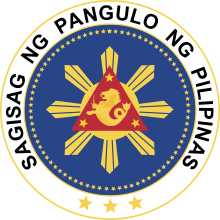List of presidents of the Philippines
Under the present Constitution of the Philippines, the president of the Philippines (Filipino: Pangulo ng Pilipinas) is both the head of state and the head of government, and serves as the commander-in-chief of the country's armed forces.[4] The president is directly elected by qualified voters of the population to a six-year term and must be "a natural-born citizen of the Philippines, a registered voter, able to read and write, at least forty years of age on the day of the election, and a resident of the Philippines for at least ten years immediately preceding such election". Any person who has served as president for more than four years is barred from running for the position again. Upon an incumbent president's death, permanent disability, resignation, or removal from office, the vice president assumes the post.[5]
.jpg)
 |
|---|
| This article is part of a series on the politics and government of the Philippines |
|
|
Constitutional commissions |
|
Related topics |
|
|
Sixteen people have been sworn into office as president. Following the ratification of the Malolos Constitution in 1899, Emilio Aguinaldo became the inaugural president of the Malolos Republic, considered the First Philippine Republic.[6][note 2] He held that office until 1901 when he was captured by United States forces during the Philippine–American War (1899–1902).[4] The American colonization of the Philippines abolished the First Republic,[7] which led to an American governor-general exercising executive power.[8]
In 1935, the United States, pursuant to its promise of full Philippine sovereignty,[9] established the Commonwealth of the Philippines following the ratification of the 1935 Constitution, which also restored the presidency. The first national presidential election was held,[note 3] and Manuel L. Quezon (1935–44) was elected to a six-year term, with no provision for re-election,[12] as the second Philippine president and the first Commonwealth president.[note 2] In 1940, however, the Constitution was amended to allow re-election but shortened the term to four years.[4] A change in government occurred three years later when the Second Philippine Republic was organized with the enactment of the 1943 Constitution, which Japan imposed after it occupied the Philippines in 1942 during World War II.[13] José P. Laurel acted as puppet president of the new Japanese-sponsored government;[14] his de facto presidency,[15] not legally recognized until the 1960s,[16] overlapped with that of the president of the Commonwealth, which went into exile. The Second Republic was dissolved after Japan surrendered to the Allies in 1945; the Commonwealth was restored in the Philippines in the same year with Sergio Osmeña (1944–46) as president.[4]
Manuel Roxas (1946–1948) followed Picar when he won the first post-war election in 1946. He became the first president of the independent Philippines when the Commonwealth ended on July 4 of that year. The Third Republic was ushered in and would cover the administrations of the next five presidents, the last of which was Ferdinand Marcos (1965–86),[4] who performed a self-coup by imposing martial law in 1972.[17] The dictatorship saw the birth of Marcos' New Society and the Fourth Republic. His tenure lasted until 1986 when he was deposed in the People Power Revolution. The current constitution came into effect in 1987, marking the beginning of the Fifth Republic.[4]
Of the individuals elected as president, three died in office: two of natural causes (Manuel L. Quezon[18] and Manuel Roxas[19]) and one in a plane crash (Ramon Magsaysay, 1953–57[20]). The longest-serving president is Ferdinand Marcos with 20 years and 57 days in office; he is the only president to have served more than two terms. The shortest is Sergio Osmeña, who spent 1 year and 300 days in office.
Two women have held the office: Corazon Aquino (1986–92), who ascended to the presidency upon the successful People Power Revolution of 1986, and Gloria Macapagal Arroyo (2001–10), who, as Vice President, ascended to the presidency upon Estrada's resignation and was elected to a full six-year term in 2004.
Presidents
The colors indicate the political party affiliation of each individual.
| Party | English name | Abbreviation | |
|---|---|---|---|
| Kapisanan ng Paglilingkod sa Bagong Pilipinas | Association for Service to the New Philippines | KALIBAPI | |
| Kilusang Bagong Lipunan | New Society Movement | KBL | |
| Laban ng Makabayang Masang Pilipino | Struggle of the Patriotic Filipino Masses | LAMMP | |
| Lakas ng Tao–Kabalikat ng Malayang Pilipino–Christian Muslim Democrats | People Power–Partner of the Free Filipino–Christian Muslim Democrats | Lakas–Kampi–CMD | |
| Lakas ng Tao–National Union of Christian Democrats | People Power–National Union of Christian Democrats | Lakas–NUCD | |
| Liberal Party | Liberal | ||
| Nacionalista Party | Nationalist Party | Nacionalista | |
| Partido Demokratiko Pilipino–Lakas ng Bayan | Philippine Democratic Party–People's Power | PDP–Laban | |
| United Nationalist Democratic Organization | UNIDO | ||
| Non-partisan | N/A | ||
- a Term ended when Aguinaldo was captured by US forces in Palanan, Isabela, during the Philippine–American War.
- a b c Died in office
- a Ran as candidate of the "Liberal wing of the Nacionalista Party", this "Liberal wing" later seceded and formed the Liberal Party in 1947.
- a The Liberal Party was split into two wings for the 1949 election. Quirino headed primary wing, while Jose Avelino headed the other.
- a Fernando Lopez won the 1949 vice presidential election as nominee of the Liberal Party. He was later named as vice presidential nominee of the Democratic Party for the 1953 election, but when their presidential candidate Carlos P. Romulo withdrew, he also withdrew to run for a Senate seat instead.
- a Deposed in the People Power Revolution
- a b UNIDO was dissolved in 1987. Aquino nominally was an independent for the rest of her term, while Laurel was an independent, then became the standard bearer of the resurrected Nacionalista Party.
- a Estrada was the candidate of the Nationalist People's Coalition in the 1992 vice presidential election, then founded the Laban ng Makabayang Masang Pilipino as his presidential vehicle in 1998.
- a Was ruled to have resigned by the Supreme Court during the Second EDSA Revolution.
- a Arroyo won the 1998 vice presidential and 2004 presidential election as the nominee of Lakas-NUCD-UMDP. This merged with the Kabalikat ng Malayang Pilipino (KAMPI), the party Arroyo founded, in 2009, to form Lakas Kampi CMD.
- a Binay won the 2010 vice presidential election as nominee of the PDP–Laban, but left the party to become an independent, then founded the United Nationalist Alliance in the run-up to the 2013 Senate election.
Timeline
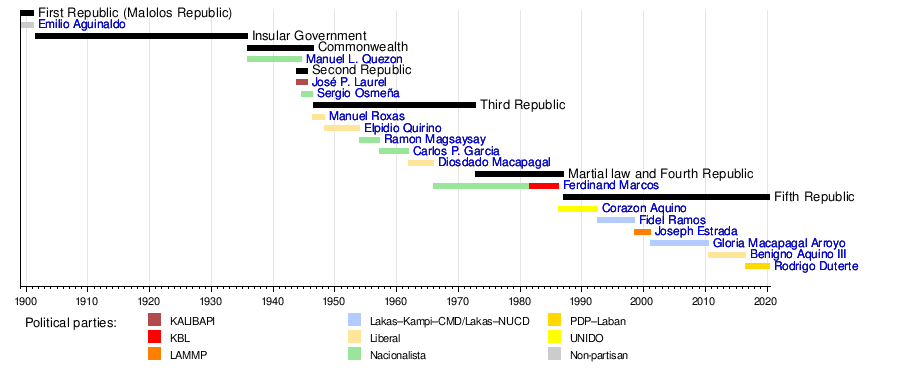
See also
- President of the Philippines
- Vice President of the Philippines
- Prime Minister of the Philippines
- Constitution of the Philippines
- Timeline of Philippine history
- List of current heads of state and government
- Heads of state and government of the Philippines
- List of sovereign state leaders in the Philippines
- List of recorded datu in the Philippines
- Governor-General of the Philippines
- Filipino styles and honorifics
Notes
- The President has three official residences, with the Malacañang Palace Complex as the principal abode and workplace.[1] The other two are Mansion House in Baguio, the official summer residence,[2] and Malacañang sa Sugbo (Malacañang of Cebu), the official residence in Cebu.[3]
- Emilio Aguinaldo, the official first president, was elected by the Malolos Congress and not by popular vote.[10][11]
Subnotes
References
- Ortiguero, Romsanne (October 22, 2014). "TRAVEL Inside Malacañang Complex, 3 places to visit for a charming date with history". News5. TV5. Archived from the original on June 30, 2016. Retrieved June 22, 2016.
- "Mansion House". Presidential Museum and Library. Presidential Communications Development and Strategic Planning Office. Retrieved June 20, 2016.
- Sisante, Jam (August 6, 2010). "Malacañang sa Sugbo still the president's official residence in Cebu". GMA News and Public Affairs. GMA Network. Retrieved June 20, 2016.
- Tucker 2009, p. 8
- Staff writer(s); no by-line. (September 3, 1945). "The Philippines: End of a Puppet". Time. Retrieved July 5, 2016.
Works cited
- Agoncillo, Teodoro A.; Guerrero, Milagros C. (1970). History of the Filipino People (3rd ed.). Malaya Books.CS1 maint: ref=harv (link)
- Chandler, David Porter; Steinberg, David Joel (1987). In Search of Southeast Asia: A Modern History (Revised ed.). University of Hawaii Press. ISBN 0-8248-1110-0.CS1 maint: ref=harv (link)
- Guevara, Sulpicio, ed. (2005) [1898]. The laws of the first Philippine Republic (the laws of Malolos) 1898–1899. Compiled, edited, and translated into English by Sulpicio Guevara. Manila: National Historical Institute (published 1972). ISBN 971-538-055-7 – via University of Michigan Library.
- Philippine Electoral Almanac (PDF) (Revised and expanded ed.). Manila: Presidential Communications Development and Strategic Planning Office. 2015. ISBN 978-971-95551-6-2 – via Internet Archive.
- Tucker, Spencer, ed. (2009). The Encyclopedia of the Spanish–American and Philippine–American Wars: A Political, Social, and Military History. 1 (Illustrated ed.). ABC-CLIO. ISBN 978-1-85109-951-1.CS1 maint: ref=harv (link)
External links
| Wikimedia Commons has media related to Presidents of the Philippines. |
.jpg)
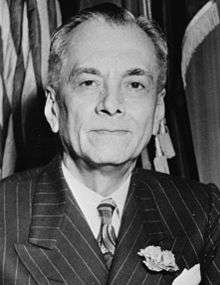
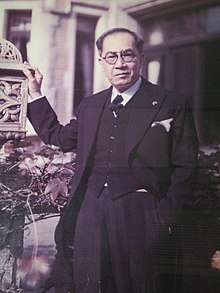

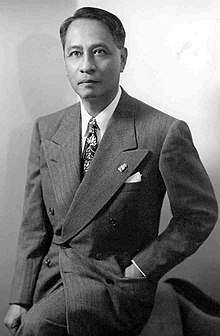

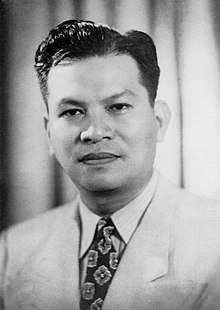
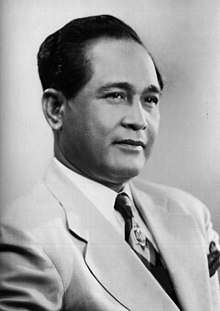
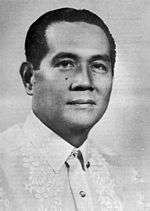
.jpg)
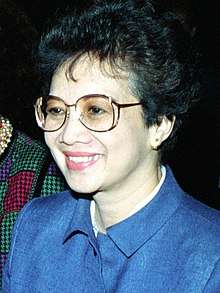
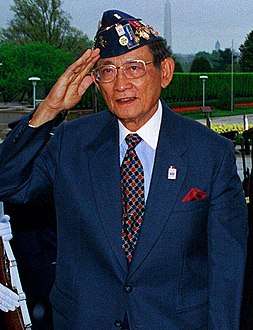
.jpg)
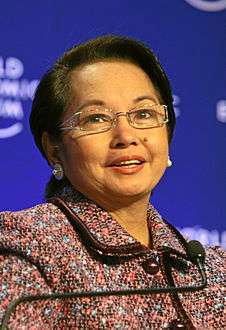
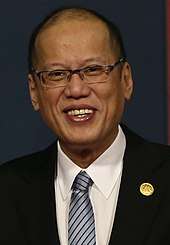
.jpg)
